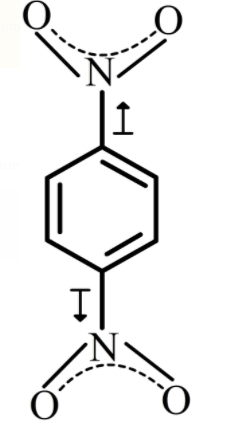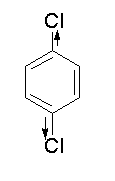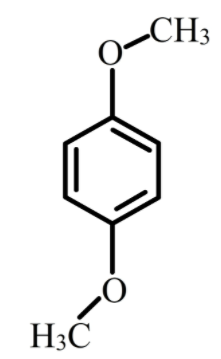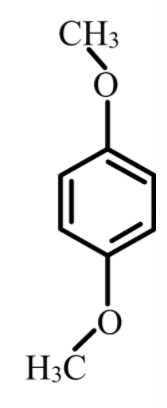
Dipole moment of (1) p-dinitrobenzene (2) p-dichlorobenzene (3) p-dimethoxybenzene are in the order:
(a) 3 > 2 > 1
(b) 3 = 2 > 1
(c) 3=2=1
(d) 3 > (2 =1)
Answer
466.8k+ views
Hint: The dipole moment is formed when there is electronegativity difference between the atoms. The dipole moment measures the compound's polarity. When the moment of dipole is towards the pair of electrons, then the dipole moment is larger.
Complete step by step answer:
The structure of p-dinitrobenzene is shown below.

There is a dipole moment between the carbon atom of benzene ring and nitrogen atom containing lone pairs of electrons. As nitrogen is more electronegative than hydrogen, then the moment of dipole is towards the nitrogen atom. As there are two nitro groups attached to the benzene ring, the dipole moment generated by both the nitro groups will cancel out each other and the net dipole moment will be 0.
The structure of p-dichlorobenzene.is shown below.

There is a dipole moment between the carbon atom of benzene ring and chlorine atom containing lone pairs of electrons. As chlorine is more electronegative than hydrogen, then the moment of dipole is towards the chlorine atom. As there are two chlorine atoms attached to the benzene ring, the dipole moment generated by both the two chlorine atoms will cancel out each other and the net dipole moment will be 0.
The structure of p-dimethoxybenzene is shown below.


The p-dimethoxybenzene exists mainly in two forms, one is cis p-dimethoxybenzene and trans p-methoxybenzene. As trans is a symmetrical molecule its dipole moment is 0 while cis form is not symmetrical molecule therefore, its dipole moment is 2.25 D.
Thus, dipole moments of (1) p-dinitrobenzene (2) p-dichlorobenzene (3) p-dimethoxybenzene are in the order 3 > (2 =1).
Therefore, the correct option is D.
Note:
Make sure if the molecule exists in different forms or not because the symmetry of the molecule changes the dipole moment in the molecule.
Complete step by step answer:
The structure of p-dinitrobenzene is shown below.

There is a dipole moment between the carbon atom of benzene ring and nitrogen atom containing lone pairs of electrons. As nitrogen is more electronegative than hydrogen, then the moment of dipole is towards the nitrogen atom. As there are two nitro groups attached to the benzene ring, the dipole moment generated by both the nitro groups will cancel out each other and the net dipole moment will be 0.
The structure of p-dichlorobenzene.is shown below.

There is a dipole moment between the carbon atom of benzene ring and chlorine atom containing lone pairs of electrons. As chlorine is more electronegative than hydrogen, then the moment of dipole is towards the chlorine atom. As there are two chlorine atoms attached to the benzene ring, the dipole moment generated by both the two chlorine atoms will cancel out each other and the net dipole moment will be 0.
The structure of p-dimethoxybenzene is shown below.


The p-dimethoxybenzene exists mainly in two forms, one is cis p-dimethoxybenzene and trans p-methoxybenzene. As trans is a symmetrical molecule its dipole moment is 0 while cis form is not symmetrical molecule therefore, its dipole moment is 2.25 D.
Thus, dipole moments of (1) p-dinitrobenzene (2) p-dichlorobenzene (3) p-dimethoxybenzene are in the order 3 > (2 =1).
Therefore, the correct option is D.
Note:
Make sure if the molecule exists in different forms or not because the symmetry of the molecule changes the dipole moment in the molecule.
Recently Updated Pages
Express the following as a fraction and simplify a class 7 maths CBSE

The length and width of a rectangle are in ratio of class 7 maths CBSE

The ratio of the income to the expenditure of a family class 7 maths CBSE

How do you write 025 million in scientific notatio class 7 maths CBSE

How do you convert 295 meters per second to kilometers class 7 maths CBSE

Write the following in Roman numerals 25819 class 7 maths CBSE

Trending doubts
Give 10 examples of unisexual and bisexual flowers

Draw a labelled sketch of the human eye class 12 physics CBSE

Differentiate between homogeneous and heterogeneous class 12 chemistry CBSE

Differentiate between insitu conservation and exsitu class 12 biology CBSE

What are the major means of transport Explain each class 12 social science CBSE

Franz thinks Will they make them sing in German even class 12 english CBSE




